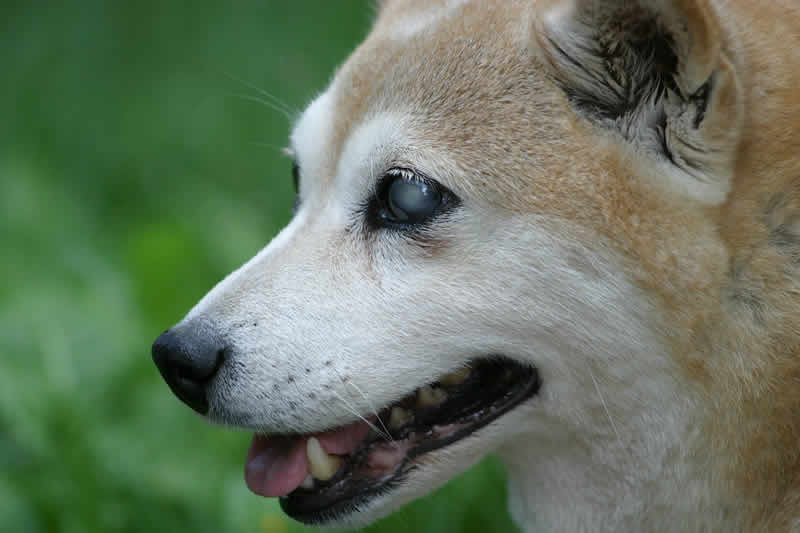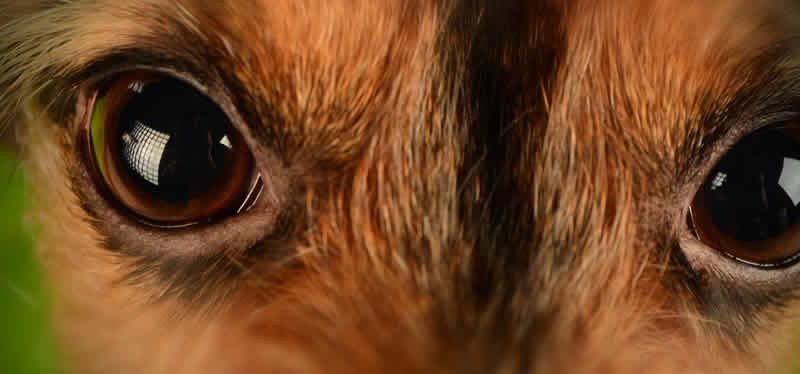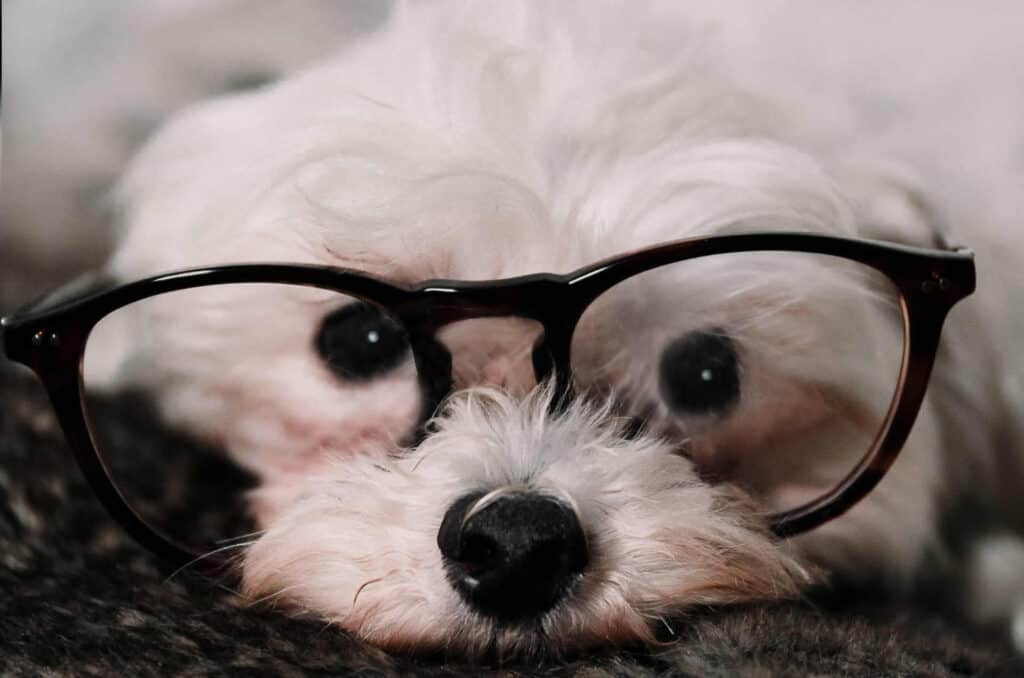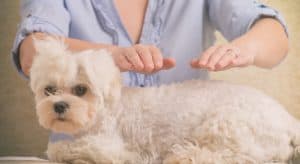When your beloved dog starts to go blind it can be a scary time for you and your pet. I remember when my first dog who was aged around nine at the time started to develop cataracts and it was indeed a worrying and anxious time. However, dogs are remarkable animals and can cope with extraordinary situations. Sometimes we can learn a lot from our furry friends as to how they deal with such situations.
Blind Dogs Can Lead Happy Lives
Just because your dog has gone blind does not mean it’s the end. Many blind dogs live life to the full and can still partake in daily activities and still continue to spread love and live a long and happy life.
In this article, we are going to look at the tell-tale signs that your dog is going blind or having visual issues. We then cover some helpful tips for you and your pooch to deal with blindness but first, we are looking at an innovative product called a blind dog halo (bumper ring or anti-collision ring) that will help your dog navigate his surroundings without any bumps or injuries.
–
Blind Dog Halo (Anti Collision Ring)
Muffin’s Blind Dog Halo was designed by Silvie Bordeaux when her dog Muffin lost his sight due to a cataract. He was depressed so she designed the halo.
Innovative Design
This 3-piece device helps dogs who are either blind or visually impaired to move freely about safely. It gives your dog the confidence to walk without bumping his head off the walls or doors.
How It Works
The halo is attached to a harness which then extends out from your dog’s head. It acts as a barrier so that it hits a hard surface it will bump against it and so protect your dog from getting a bang or knock on the head. Your dog will quickly learn how to use the halo and so his confidence in moving freely will be boosted.
Various Sizes Available
The muffin halo comes in a variety of sizes. This is a great help as the halo needs to fit snuggly onto your dog as otherwise, it will slip around and not work in the correct manner. There are measurement charts available so that you can get the right fit for your pooch.
How to Assemble The Halo

The Pros
Innovative 3 piece design
Well made with good quality components
Protects your dog from bumps and injuries while moving around
Variety of sizes available
The Cons
Quite expensive
Haploon Blind Dog Harness
The Haploon Blind Dog Harness is another type of halo or anti-bumper/anti-collision ring.
It works the same way as the Muffin Halo. It helps visually impaired or blind dogs navigate throughout their surroundings.
Lightweight
The halo is composed of polyester which is lightweight and so will not be an extra burden for your dog to carry around.
Sizes
There are 3 choices of size with this halo – extra small, small, and medium. It’s important that the halo fits snuggly onto your dog so that it can work more effectively
The Pros
More competitively priced than similar products
Helps prevent bumps and injuries
The Cons
Some users found halo hoop a little too flexible
Limited to only 3 sizes
DIY Option
There is always the option to make a bumper yourself for your dog. Now I’m not great at DIY myself but if you are then there is the possibility you can construct your own dog halo. This YouTube video may give you help with this endeavor.

Signs to Watch for Blindness in Dogs
Sometimes it can be quite obvious to see that your dog is going blind. One of the more obvious signs is a clouding of the eyes due to cataracts. Other times it is not so easy to spot as dogs are very adaptable and quite cunning in hiding some signs. However, there are some tell-tale signs to watch for so that you can be prepared and then consult with your veterinarian as to the course of action to take.
1. Clouding of Dog’s Eyes
You may notice that something is not quite right with your dog’s eyes or eye. There may be a clouding of his eye with a pale gray film. This can range in size from a small dot to a complete circle covering the eye. This normally indicates the development of either cataracts or glaucoma. This can happen very gradually over time and initially may not be noticeable.
In some cases, your veterinarian can help solve the loss of vision through surgery. Cataract surgery involves replacing the lens with either a plastic or acrylic one. This type of surgery is often successful in restoring your dog’s vision, however, as with any type of surgery there are always risks and sometimes it may not be possible to perform due to your dog’s health or age. Sometimes the risks can outweigh the benefits and it’s something you can discuss with your vet or health professional.
2. Reduced or No Eye Contact
You may notice that your dog no longer looks directly at you or just makes very little eye contact. This could be a sign that his vision is impaired as he can no longer make out where exactly you are situated.
3. Bumping into Furniture etc
With the onset of blindness, your dog may appear to be clumsy and start bumping into obstacles around the house such as furniture and furnishings.
4. Scared Easily
It can often be a scary and anxious time for your dog when he starts to lose his vision. Place yourself in your dog’s position. A dramatic change like vision loss could result in your dog being suddenly being scared of noises which he has heard all his life. It may seem odd that he reacted contrary to his normal behavior on hearing the noise.
5. Confusion
Often times your dog could become confused and not sure which way to walk or move for fear of hurting himself. As he can no longer see his surroundings things could be confusing so he may freeze to the spot until he hears your voice of reassurance.
6. Depression
Dogs can suffer from depression just like humans. Consequently, your dog may have lost interest in fun activities and may be reluctant to engage with others. He may also sleep more than usual and not be consistent with normal nap times
It can be a tough time so reading the signs so that you can help with the onset of blindness will mean you can seek professional help before the situation worsens.

Reasons for Dog Blindness
1. Old Age
Time catches up on us all and unfortunately so much faster on your dog. As dogs age their eyesight can deteriorate and be susceptible to eye infections.
2. Genetics
Certain breeds of dogs are more prone to vision loss than others. At the end of the day, it boils down to their genetic make-up. Dog breeds such as Labradors, Golden Retrievers, and Rottweilers can be more susceptible to blindness.
3. Progressive Retinal Atrophy in Dogs
This is a group of degenerative diseases that affect your dog’s photoreceptor cells leading to dog blindness. There are basically 2 types – early-onset and inherited form.
Source: VCA Hospitals
4. Cataracts
A dog develops a cataract when the lens of the eye clouds over. This means that light can no longer pass to the retina and ultimately causes blindness in your dog. Cataracts can either develop slowly or even sometimes overnight
If you suspect that your dog is developing a cataract it is best to seek out medical advice from your veterinarian. The normal procedure to deal with cataracts is either through surgery or medication.
5. Various Diseases
Unfortunately, many diseases can cause eye vision problems in dogs such as diabetes, Lyme disease, distemper, parvovirus, and dry eye.

5 Helpful Tips for Blind Dogs
1. Dog Proof Your Home & Surrounds
Just as you would do with a child you need to make sure there is nothing in your home that can cause injury to your blind dog. This may involve getting rid of sharp edges, placing a guard barrier on the stairs, pet-proof the outdoor pool, fencing the garden so that he does not wander onto the road, tie up any loose dangling wires from lamps and electrical devices, etc
2. Keep The Same Layout at Home
If you start rearranging furniture, tables, and chairs, etc it is going to cause some real problems for your vision impaired dog. He will already know the layout and is able to maneuver around the house safely and successfully. However, as soon as a change is made it could cause problems and ultimately cause an injury.
The same goes for his water and food bowl. Make sure you always keep them in the same spot as moving them around will confuse your dog and lead to anxiety and possible distress.
3. Exercise
When going out for a walk make sure you have your blind dog on a leash or preferably a harness as it can guide your dog better through any obstacles you may encounter. It will help guide him through any obstacles that you may encounter while out and about.
4. Dog Training
Regardless of your dog’s age, it is never too late to train your dog. Many older dogs can learn new tricks despite the old saying you can’t teach an old dog new tricks. With the loss of sight, you can still continue to teach dog training and some helpful hints are listed below
- Keep It Simple. Do not complicate your verbal dog commands with complicated words – use just one word for each command and stick to that word. You can refer to our article on Dog Training.
- Be encouraging and use Positive Reinforcement techniques.
- Clicker training is often recommended by dog trainers, especially for blind dogs. When your blind dog performs the desired behavior you use the clicker and then give a treat. This will reinforce this positive behavior.
6. Talk & Encourage Other Senses
It is helpful to your dog is you encourage him to use his other senses. Always talk to your dog to give reassurance. If you have more than one dog it might be a good idea to place a small bell on his collar so your blind is aware of the other dog’s presence.










